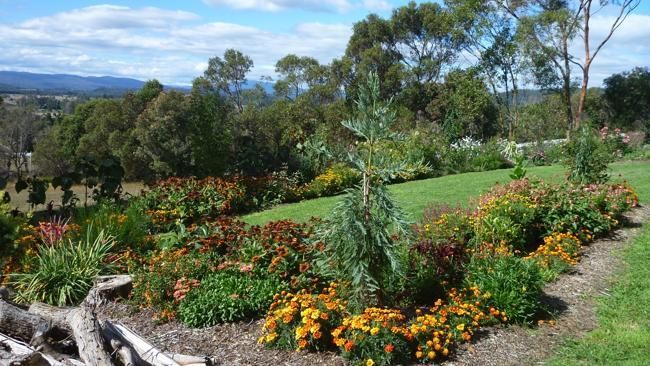Open Garden: Grey Sands Vineyard
GREY Sands Vineyard, Tasmania, features a variety of plants from cool, Mediterranean and subtropical climates.

GREY Sands Vineyard, Tasmania, features a variety of plants from cool, Mediterranean and subtropical climates.
DESCRIBE YOUR GARDEN: We’re about half an hour from Launceston, overlooking the river valleys and out to Mt Arthur. The garden is about one hectare, but still expanding since we both retired from our offsite jobs. It’s an informal, collector’s garden over several levels, divided into distinct areas to utilise different microclimates. The vineyard covers 3.5 ha, with 18 varieties we’ve planted gradually since 1988. It was just paddocks when we moved here from NSW. We planted native windbreaks immediately, bucketing out of the dam to water them each weekend. We moved into our new “shed”, insulated and cosy, in 1989 with our 14-month-old son, supposedly for 12-18 months, but it was six years and another son later before we got a house built. Bob is the gardener; Rita a more recent convert.
WHAT MAKES IT SPECIAL: The stately deciduous trees and conifers give it structure, but smaller, detailed plantings of flowering shrubs and perennials extend the show for the longest possible period. There’s a diversity of plantings from cool, Mediterranean and subtropical climates.
BIGGEST CHALLENGES: Late summer dryness and low fertility, grey sandy soil.
LESSONS FROM YOUR GARDEN: Create sheltered areas with evergreens to the southwest and deciduous to the northeast. This moderates temperatures.
WHAT’S LOOKING GOOD: Grapes on the vines. Salvias reign in autumn, with roses, late annuals and perennials. Layers of deciduous leaf colour eventually dominate.
EXTRAS: Barbecue run by West Tamar Rotary, free wine tastings and sales by the glass and bottle.
6 Kerrison’s Rd, Glengarry. Owners Bob and Rita Richter. Open this weekend and Monday 10AM to 5PM. Entry $7, Under 18s Free
FLORA:
A NEW fruit to watch for is jujube or Chinese date Ziziphus jujube, available as fresh, apple-like fruit from February until late April, and as dried fruit through the year.
Grown in China for thousands of years as food and medicine, jujube is now grown in Western and South Australia, and Victoria. It’s a small deciduous tree, with shiny green leaves and some thorns, very tolerant of frost, heat, drought, salt and limestone soils — which will make it popular in regions where few other fruit trees thrive.
Jujubes have sweet, white flesh and thin red skin, and are high in vitamin C and B-complex, antioxidants and minerals. McLaren Flat-based Chris Perry has three varieties available: Li, Chico and Lang.
(08) 8383 0268 or perrysfruitnursery.com.au
TWIG
Q: Ten years ago, a large she-oak with borers was cut down. A Grevillea ‘Honey Gem’ planted there got borers after several years and died. Now another nearby grevillea suffers the same.
Lissa Fry, Brisbane
A: Borers only successfully attack trees already weakened from poor growing conditions, old age or other stresses. You can check for attack sites with the telltale frass and poke a wire down the holes but the main treatment and prevention is to improve the health of the trees.
Q: Our daphnes started ailing a year ago; the stems are almost bare and new leaves don’t develop. Initially they responded to fertiliser and water but not any more.
Vicki Lopow, Melbourne
A: Daphnes are infamously tricky to grow, succumbing easily to root rot and viruses. Viruses are incurable but root rot such as phytophthora can be treated if caught early, using phosphorus acid (Yates Anti-Rot). Badly affected plants are past saving. Don’t replant in the same spot; try daphne in pots.
Q: In one bed, my tomatoes’ roots developed small nodules but not in another. Is this an infection?
M. Turner, Adelaide
A: Root knot nematode is a microscopic pest, common in sandy soils, causing lumps along roots of tomatoes, potatoes, carrots, cucurbits, gardenias, roses and others. Infected plants wilt and are stunted. Destroy them. Practise crop rotation; corn, onions and some brassicas are safe. Grow a thick crop of mustard or marigolds and turn them in. Add organic matter to soil.
Q: Two types of grasshoppers are stripping my palms bare. Is there a spray or humane solution?
Elizabeth Lee, Morayfield, Queensland
A: Grasshoppers are easiest to catch with a net early on cool mornings. Major predators are birds, chickens, lizards, frogs, assassin bugs, paper wasps and robber flies. Coriander, dill and alyssum flowers attract predatory insects. Make traps of canola oil in yellow containers. Organic Eco-Neem is registered overseas to control grasshoppers but not here.
Send your questions to: helenyoungtwig@gmail.com or Helen Young, PO Box 3098, Willoughby North, NSW 2068. Website: helenyoung.com.au



